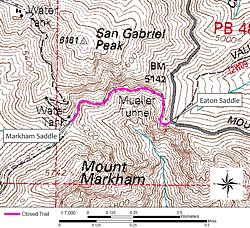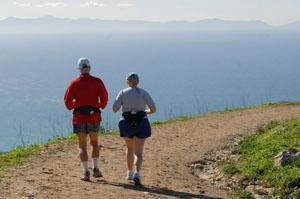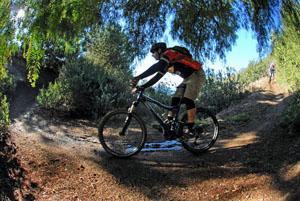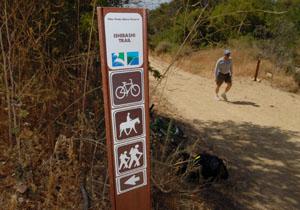A community meeting is scheduled for Monday, August 31 at 7pm at the WLA Municipal Center (1645 Corinth Ave, LA 90025) arranged by the Brentwood Community Council and Councilmember Rosendahl’s staff. Southern California Gas Company representatives will explain their project in greater detail and provide attendees an opportunity to ask their questions. The gas company still plans to close their canyon property to the public beginning September 1, 2009 and expect to re-open the canyon when the work is complete.
Archive for the ‘Trail Access’ Category
August 31 Public Meeting on Sullivan Canyon Closure
Tuesday, September 1st, 2009Mt Lowe Truck Trail Closure
Friday, June 19th, 2009 June 19, 2009
June 19, 2009
Due to a recent rock slide, the section of the Mt. Lowe Truck Trail (Forset Trail No. 2N50) is closed from its intersection with Eaton Saddle, continuing west 1/2 mile to its intersection with Markham Saddle as shown in the picture. The trail was closed starting on June 9th and the closure is in effect until June 8, 2010.
A 150 foot portion of the Mt. Lowe Truck Trail collapsed during a rock slide making it dangerous for public access. The rock slide has created a narrow section requiring trail users to traverse on a narrow section with loose gravel and soil. The remainder of the trail will remain open with signs posted at the beginning and end of the trail in addition to signs at the actual slide area.
Angeles Chapter of the Sierra Club works to keep mountain bikes off trails in Los Angeles
Monday, June 1st, 2009Chapter activists working to keep city parks hiker-friendly and mountain-bike free
By Carol Henning, Co-Chair, Southern Sierran Editorial Board. The following article appears in the June 2009 edition of the Southern Sierran, Vol 65 No6.
You’re hiking down a steep trail, enjoying the view, trying to remember the name of a trailside wildflower when, whoosh! Inches from your left arm a mountain bike comes careening down the trail. Most close encounters with mountain bikes leave all parties unharmed – most, but not all.
“We have seen conflicts,” reports Kevin Regan of the Department of Recreation and Parks. There have been “close calls and accidents.” A Los Angeles City Ordinance prohibits bicycles on unpaved trails in all City parks. This ordinance was reaffirmed unanimously by the City Council in 2000. Moreover, this April, the Angeles Chapter passed a resolution supporting efforts to uphold the existing ordinance.
The backstory has been documented by Sierra Club hike leader, AI Moggia. 1995 saw the Concerned Off Road Bicycle Association (CORBA) requesting access to dirt trails in city parks from the Department of Recreation and Parks (DRAP), whereupon a Mountain Bike Task Force was formed including CORBA, DRAP, the L.A. Department of Transportation (LADOT and the L.A. Bicycle Advisory Committee (BAC). The L.A. City Planning Department spooned up this alphabet soup and other entities to formulate a Bicycle Plan Element. In 1996, the DRAP Commission denied requests for a mountain bike event in Griffith Park, citing the municipal ordinance and an opinion by the City Attorney. Also in 1996, the City Council adopted the Bicycle Master Plan as part of the Transportation Plan Element of the General Plan of L.A. City.
DRAP, CORBA, DOT and BAC studied the feasibility of opening City parks to mountain biking.
In 1998, LADOT City Bicycle Coordinator Michelle Mowery and BAC member Alex Baum made a special presentation to DRAP. There was minimal public notice of three community meetings in 1999, but over 400 residents attended. 95 percent of the attendees expressed their opposition to biking on city parks’ dirt trails. Despite the apparent dearth of public support, Elysian Park was selected in January 2000 for a mountain bike pilot program. Word of mouth and work by the Citizens’ Committee to Save Elysian Park brought out more members of the public to a meeting at Grace Simons Lodge, where they opposed the mountain bike pilot program. A subsequent meeting brought out more community members, a vast majority of whom opposed the program. Elysian Park was spared, and the City Council passed the motion rejecting changes to the ordinance prohibiting mechanized use of City park trails.
Mountain bike advocates tightened the straps on their helmets and soldiered on. Perhaps feeling jilted by Recreation and Parks, they decided to hop onto the handlebars of the Department of Transportation. But is this not an issue of recreation rather than transportation? The DOT’s Bicycle Master Plan is about cycling in the City. The focus is presumably on the transportation aspects of the bicycle plan, not on the thrills of jouncing down a narrow dirt trail, dodging (one hopes) hikers, runners and equestrians.
A September, 2008, memo by Jordann Turner, Bike Plan Project Manager, wondered “why and how the meetings in the past between cyclists/equestrians/etc. have been contentious.” Might it have been those accounts of clobbered hikers, frightened horses and thrown riders? To avoid this sort of testimony, DOT decided to use a consultant who has experience with this subject matter to conduct small mediated working-group meetings. Attendance at these meetings was by invitation only, with no notice to the public. The Los Angeles Bike Plan Stakeholder Advisory Group consists of nine invited participants – three hikers, three mountain bikers and three equestrians. Where are the runners? Where are the dog-walkers? Where are the homeowners associations’ representatives? They were not invited to the table.
It seems clear that the question is not whether mountain bikes should be permitted in City parks but which parks should allow them and how should access be designed. Two Sierra Club members represented hikers’ interests at the first meeting. Neither was an official representative of the Angeles Chapter. After the show, the distinction between being a Sierra Club member and a designated Sierra Club spokesperson was explained to the facilitators. supposedly neutral consultants with ties to to the Osprey Group of Boulder, Colorado, whose website documents its experience securing trail access for mountain biking.)
| Webmaster’s note: Michelle Mowery, Bicycle Coordinator for the LA City Dept of Transportation (LADOT) testified recently that “The Needs Assessment … identified bicycling and walking trails as the number one need. … It identifies equestrian use as last on that list. So it’s clear that there is a need and a desire for bicycle facilities within the parks.”
For more on this issue, including video clips of outrageous claims during testimony, visit our LA City Parks web page. |
Club policy on mountain bikes opposes their use in officially designated wilderness areas unless determined to be appropriate by analysis, review and implementation. The Park City Agreement (1994) between the Sierra Club and the International Mountain Bicycling Association called for site-specific analyses and stated that not all non-wilderness trails should be opened to bicycle use. Of concern are the effects of off-road biking on soil erosion, the impacts on plants and animals, and the displacement of other trail users. When considering the introduction of off-pavement bikes to a park, Sierra Club guidelines mandate consideration of these issues: whether the safety and enjoyment of all users can be protected, and whether there has been a public review and comment procedure for all interested parties. In this case, the response is no.
A late 2008 DRAP Citywide Parks Needs Assessment demonstrated virtually no demand for mountain biking [Webmaster’s note: See the inset at right to evaluate the accuracy of this claim]; yet, a small advocacy group seems to be trying to sneak its agenda past an unsuspecting public. Most of us have not been invited to join the discussion, but we can make our voices heard. Send letters and e-mails to LADOT, to DRAP and to your city councilmember.
Urge California Decision Makers to Adopt Bike-Friendly Land Protection Measures
Friday, June 27th, 2008June 27, 2008
From the International Mountain Bicycling Association
The Assembly Committee on Natural Resources recently passed a bill — authored by Assembly member Noreen Evans (D-Santa Rosa), Chair of the Assembly Democratic Caucus — that directs the state to assess the suitability of numerous state lands in Northern California for Wilderness designations.
Bicyclists value natural landscapes and access to trails that bring us closer to nature. Because our activity is a quiet, low-impact and human-powered use that is compatible with wild settings, we believe many of these Northern California areas should not be protected with Wilderness designations, which would effectively prohibit bike access.
IMBA California Policy Advisor Tom Ward has testified in front of the committee and many members expressed their support for mountain biking — but they still passed the bill out of committee. Unless they hear from the mountain bike community, the bill will keep moving and suggest massive closures at three important parks.
There are many ways to protect these important places without banning the existing use of mountain bicycling. Cyclists need to rally and make sure their assembly member hears from our constituency.
Take Action!
IMBA’s simple online comment form takes seconds to complete! Tell the governor and your state senator and representative you support land protection that allows bicycling to continue.
A quick phone call can be even more effective. Click here to find contact information for your elected officials.
Please also forward this alert to all mountain bikers, bike shops and industry employees you know.
Additional Information
Assembly Bill (AB) 2923 passed from committee with a 6-2 vote and awaits further review in the Assembly Appropriations Committee
Sponsored by the California Wilderness Coalition, the bill directs the Resources Agency and the State Lands Commission to assess whether selected state lands merit wilderness designation.
Mountain biking is an existing use in several of these areas, including Robert Louis Stevenson State Park and Henry W. Coe State Park.
Mountain bikers also have a long-standing proposal to create shared-use trails in Austin Creek Redwoods State Park.
Because Wilderness designations would prohibit bike access in these parks, we urge that these areas should be protected through other means.
IMBA California’s Tom Ward is meeting with key Senate staffers and will keep the pressure up to ensure that mountain bike access is protected.
New Rancho Palos Verdes policy for bikers, hikers and equestrians satisfies few
Saturday, June 7th, 2008June 7, 2008
 Runners take the Burma Road through the Portuguese Bend Reserve. Because preserving habitat takes top priority, the city of Rancho Palos Verdes has established limits on the use of trails in the reserve. The trails were reopened to the public under the new rules Friday. (Steve McCrank, Staff Photographer) |
By Melissa Pamer, The Daily Breeze Staff Writer
With some of the most sublime ocean views in the South Bay, the steep, narrow trails in Rancho Palos Verdes’ Portuguese Bend Reserve draw fierce allegiance and occasional territoriality from hikers, mountain bikers and equestrians alike.
Now, following the reopening Friday of the 417-acre canyon park after a four-month trail closure, a new set of rules – dictating which trails may be traversed on foot, on bike or on horseback – will be put to the test.
Few are pleased with the new access plan, which was created after months of debate by a citizen committee and approved by the City Council earlier this year.
“We’ve gone with the least bad solution,” said Gordon Leon, a member of the committee who counts himself as a representative of all three “user groups.”
“The fact that nobody’s happy means that everybody had to make compromises. Any way you look at it, by allowing people up there, you impact habitat,” Leon said. “When it comes right down to it, at the top of the priority list is habitat. Then there’s everything else.”
Under the plan, cyclists will have access to far fewer trails, and many of the most challenging and popular paths will be off-limits to bikes. More than half of the trails will be closed to all users. There are no signs barring access to closed trails – so if a trail isn’t marked, its use isn’t allowed, officials said.
Enforcing the new rules may prove a challenge, council members acknowledged at a Tuesday meeting in which they approved the reopening of the reserve.
“When I last looked, the signage was still inadequate,” Councilman Tom Long said before voting in favor of the reopening. “We need resources to enforce the rules.”
For now, the Sheriff’s Department is responsible for enforcement. City staff will request sporadic visits from deputies if there are regular
reports of illicit trail use. Penalties for violators – currently subject to a fine of up to $1,000 under city code – may change if the city follows a Sheriff’s Department recommendation to give only a written warning to first-time offenders. So far, it’s clear that what some called a “lawless” atmosphere hasn’t entirely changed. Earlier last week, before the side trails reopened, evidence could be seen that the closure had not left the area to the lizards. Prints from hiking boots, hooves and tires marked dusty side trails. Hikers could be seen in off-limit areas of the reserve. At one juncture, a new trail sign had been shorn off at its base.
So far, it’s clear that what some called a “lawless” atmosphere hasn’t entirely changed. Earlier last week, before the side trails reopened, evidence could be seen that the closure had not left the area to the lizards. Prints from hiking boots, hooves and tires marked dusty side trails. Hikers could be seen in off-limit areas of the reserve. At one juncture, a new trail sign had been shorn off at its base.
It may take time for the new rules to be respected, said Andrea Vona, executive director of the nonprofit Palos Verdes Peninsula Land Conservancy, which manages the reserve along with other nearby areas. She’s hopeful that signs and a new map will keep users in line.
“Our general philosophy is it’s going to take community buy-in – to make this a successful reserve – from all user groups,” Vona said.
The city’s “timeout,” which began Jan. 31 and was intended to allow the land to heal from overuse, interrupted a decadeslong period of unregulated recreation in the canyon area.
Purchased in 2005 for $17 million – funded largely by grants and $4 million raised from the community – the coastal sage scrub-covered land had been long used by the public with the tacit approval of a private owner. The trails that crisscross the hillside, some running parallel and just feet from each other, offer scenic hiking and horseback riding. With its sharp turns and steep descents, the area became popular beginning in the early 1980s with mountain bikers, some of whom cleared brush for spots to perform tricks.
“It’s been sort of a free-for-all,” said Ara Mihranian, the city’s principal planner. “There were areas that were used for jumps and free-riding. That’s no longer part of the plan.”
The new reserve entered the spotlight in July 2006 when the Public Use Master Plan committee, a 15-member citizen group, began analyzing uses of all the city’s open space, including nine other reserves. Some members, who viewed bikers as harmful to the reserve and disruptive to peaceful hikes and horseback rides, wanted cyclists barred from the area altogether.
“It’s an organized assault. It’s not just locals; they come from all over,” said former Mayor Ann Shaw of the cyclists’ use of the reserve. A member of the PUMP citizens committee, Shaw came down firmly against the bikers.
 “If you’re exhilarated it ought to be from the scenery, not because you’re going fast,” Shaw said. “(Bikers) are not there for the primary purpose of the preserve, which is preservation of the flora and the fauna.”
“If you’re exhilarated it ought to be from the scenery, not because you’re going fast,” Shaw said. “(Bikers) are not there for the primary purpose of the preserve, which is preservation of the flora and the fauna.”
Participants said the PUMP meetings became repetitive rehearsals of conflicts between equestrians, hikers and bikers. Some detailed instances of confrontation on the trail, particularly between bikes and horses. Differing views on the groups’ own effects on habitat and trail degradation also separated the sides.
The cyclists’ defense fell in part to committee member Troy Braswell, who in 2004 helped found a local branch of Concerned Off-road Bicyclists Association, or CORBA, which seeks to protect biker access and maintain trails.
The group – which numbers around 250, Braswell said – has done regular restoration work on the city’s trails, including the 154-acre Forrestal Reserve, next to Portuguese Bend.
Under a previously approved city plan, most trails in Forrestal remain open to all users. But the area is less popular with bikers than the neighboring reserve, which bikers sometimes call “Del Cerro” after a nearby municipal park, Braswell said.
On Saturday, National Trails Day, CORBA was set to co-sponsor several hours of volunteer work in Portuguese Bend, which is treasured as some of the best riding in central Los Angeles County, and by far the best in the South Bay.
Braswell acknowledged that a few irresponsible or disrespectful riders have made a bad name for bikers in the reserve. But he said incidences of conflict between user groups were rare.
“The habitat issue is bikers going off trail. I have to admit, that has occurred,” Braswell said. “The people who were doing that had no understanding of the habitat, and there was no rules or no management at all that told them what to do. We call it the vacant lot mentality.”
`Free-for-all’ culture
Areas off limits to cyclists
Since CORBA-Palos Verdes was founded, the group has sought to educate riders on proper trail etiquette and respect for the environment, Braswell said. But that hasn’t seemed to sway enough supporters to their side this time around.
 Ishibashi trail is open to all users, but cyclists are barred from the wide Ishibashi Farm trail, which they argue can accommodate more use. (Steve McCrank/Staff Photographer) |
Under the new rules, the Grapevine, a Portuguese Bend trail beloved by mountain bikers, has been limited to horses and hikers. Two wide trails – Ishibashi Farm and Water Tank – that can accommodate multiple users more easily than most of the reserve’s narrow paths have also been deemed off-limits for cyclists. And, because so many small spur trails have been shut down, paths that are shared among all three user groups will be more crowded, Braswell said.
“By closing so many trails, they’ve basically cut bikes out,” Braswell said.
But some who have been critical of bikers aren’t thrilled with the outcome either.
“There are no victories,” Shaw said. “I will be happy when we see the trails being actually used properly.”
The city is set to review the trails plan for Portuguese Bend Reserve in six months.
The Mount Hillyer Project
Monday, May 12th, 2008May 2, 2008
CORBA is pleased to announce the approval of our proposal for a new trail in the Angeles National Forest. The new Rock & Rail Trail will be a 1 mile long trail at the summit of Mount Hillyer near Chilao. It will include many technical features. Read all about it on our Mt Hillyer Project web page.
Mustard Growth on the New Millennium Trails in Calabasas
Friday, May 9th, 2008 May 9, 2008
May 9, 2008
Spring has sprung and so did the Mustard plants! The New Millennium Trail has become so overgrown with this plant the trail is unusable at this time! The CORBA Trail Crew was out on 4/15 and 4/17 working on the trail. It was a slow process but we managed to clear .7 of a mile from the intersection of the Bark Park Trail heading south. There is still much work to be done!
CORBA has been communicating with the Mountains Restoration Trust (MRT) to come up with a solution to get this great trail passable once again! The MRT has mobilized their Crew to work on brush removal on the trail. The CORBA Trail Crew returned to the trail on 5/9 and worked on some slides and erosion problems on the South side of the trail near Normans Way.
The MRT Crew has cleared the brush from Parkway Calabasas past Normans Way/Stokes Canyon to the switchbacks and Parkway Calabasas towards Calabasas Road/Gun Club Road past the water tank on the ridge above the other set of switchbacks.
We hope to be able to report very soon that the entire trail is once again usable!
Web pages to check out:
December 7, 2008 Update: The trails are completely clear of mustard and other weeds.
Bicyclist in trouble again over illegal trail at China Camp
Thursday, May 1st, 2008by Gary Klien, Marin Independent Journal
More is accused of digging an illegal bike trail into a hillside, hacking down tree limbs and constructing rock paths through two drainage ditches, authorities said. The quarter-mile trail is at the end of Robinhood Drive in San Rafael’s Glenwood neighborhood, which borders the state park.
The cost of repairing the damage is estimated at $20,000, said Kathryn Mitchell, a senior county prosecutor.
Dave Gould, the superintendent overseeing state parks in Marin, said the damage to the natural resources was “significant.”
“It looks like chainsaws were used and trail-building tools to carve out the hillside,” he said. “This isn’t where 15 people walked up and down the hillside and you can see their path – this is an attempt to construct an illegal trail.”
More, who could not be reached for comment, has pleaded not guilty. His attorney, Patrick Ciocca, said More would be “loathe to engage in a public discussion” about the allegations while preparing his defense.
“It would not be beneficial for him to enter into a public dialogue,” Ciocca said.
Park rangers received a tip about the trail in March, when a resident noticed unusual activity in the area. A ranger investigating the trail found More at the scene, and More allegedly tried to flee.
More was cited, but not arrested, while prosecutors reviewed the case. He is scheduled to be appear in court on May 9.
Alex Burnham, president of the San Rafael-based Access4Bikes advocacy group, said he is concerned that the case will tarnish the entire bicycling community and inflame tensions between cyclists and noncyclists. The issue of trail use has fueled years of acidic conflict among hikers, bikers, equestrians and dog owners, with the county sometimes resorting to barbed wire to block cyclists from trails.
“We do not condone this behavior,” Burnham said. “We advocate for legal trails. In Marin County, the trail user community is so polarized that anything that occurs is a blight that gets thrown on the community of mountain bikers.”
More was once a prominent bicycling activist, serving on the Marin County Open Space District Trails Committee. But he resigned the position in 2001 when federal authorities accused him and two other men of carving a four-mile illegal bike trail into the Golden Gate National Recreation Area near Bolinas Ridge.
All three men were indicted by a federal grand jury and eventually pleaded guilty to misdemeanors. They were ordered to pay more than $34,000 in restitution for the destruction to federal property, placed on probation for three years and banned from the federal park system during probation.
They apologized in court.
Good News from Palos Verdes
Wednesday, March 19th, 2008March 19, 2008
After the recent disappointment of the Portuguese Bend meeting, mountain bikers in Palos Verdes really needed a positive outcome. It came late Tuesday night at the Rancho Palos Verdes City Council meeting.
Some speakers claimed that bikes destroy habitat and endanger other users, and therefore should not be allowed on trails at the Forrestal Reserve.
Fortunately, factual data in the city-ordered Forrestal Monitoring Report supported our claims that bikes present no more problems than other users. In fact, the report stated that there has not been a single complaint against bikers.
As a result, the trails plan at Forrestal remains intact with the exception of Cristo Que Viento, which was changed to pedestrian. Bikers seldom use this trail because it’s incredibly steep and goes into Rolling Hills.
It appears that the City Council is beginning to grasp the needs of the entire community in this complex issue. Some councilmen asked detailed questions from mountain bike speakers. One questioned whether CORBA-PV could fulfill its promise to help educate local bikers. Yes, we can! Now It is up to everyone who rides in Palos Verdes to ride responsibly and continue to volunteer for trail work. These are the keys to more trail access for bikes.
After being disappointed at last meeting’s results for Portuguese Bend, we feel rejuvenated. We owe a big thanks to the eight resolute bikers who came to the meeting. You rose from the ashes to fight again. You are all heroes here! Thank you.
Truce Called in Palos Verdes Trails Controversy
Monday, February 25th, 2008February 25, 2008
From The Daily Breeze Online
By Josh Grossberg, Staff Writer
Horse enthusiasts and bicycle fans are going to have to learn to get along – or at least tolerate each other – under a plan approved Saturday by the Rancho Palos Verdes City Council.
After hearing from nearly a hundred speakers during a daylong session, the council voted 4-1 to reopen the 420-acre Canyons Ecological Reserve to both four-legged animals and two-wheeled conveyances, with only Councilman Peter Gardiner voting against the proposal.
When the trails will open, however, remains in question.
First, trail signs must be posted, educational material prepared and an enforcement plan put in place. It could be months before any of that happens.
And another thing: The park isn’t called Canyons Ecological Reserve anymore. Earlier in the day, council members voted to change the name to the Portuguese Bend Reserve. They also agreed to change the city’s entire 11,000-acre chain of wilderness areas from the Portuguese Bend Nature Preserve to the Palos Verdes Nature Preserve to avoid any confusion for visitors.
“The minute you step into Torrance, nobody’s heard of it,” Councilman Tom Long said of Portuguese Bend.
Four other less controversial trail plans also were approved. With four more to go, the council decided that after nine hours of discussions it had had enough and voted to postpone further talks until next month.
So many people showed up to the meeting at the Point Vicente Interpretive Center that a television had to be set up outside, and people watched under a steady late-afternoon drizzle.
Although the council conceded that adjustments will probably have to be made, the new plan calls for horse riders and bicyclists to share many of the winding trails.
Other paths can be used by horses, but not bikes. Bikes can use some, but not horses. And hikers get to use all of them.
“We should open it up to all users, provided it’s safe,” Gardiner said.
The majority of the speakers were horse riders who said that while most bicyclists are courteous, many ride down hills too fast, take turns dangerously and generally spook the horses. They also complained that bicycles are eroding the terrain and destroying plants.
“They do what they want when they want,” one speaker said.
It was a refrain heard dozens of times during the day. Horseback riders acknowledged that bike riders had a right to enjoy their hobby. They should just do it somewhere else.
“The only part of nature they enjoy is gravity,” said Rancho Palos Verdes resident Judy Herman.
But bike riders said that while there will always be reckless people, most of them are well-behaved.
“There will always be people who don’t follow the rules,” said Rancho Palos Verdes resident George Hicks. “Embrace the responsible user.”
In the end, most people seemed satisfied with the truce – at least for now. And as Mayor Doug Stern reminded everybody more than once, figuring out how to share such a beautiful piece of real estate isn’t exactly the biggest problem in the world.
“This is a wonderful position to be in,” he said. “You all go out victors no matter what.”




